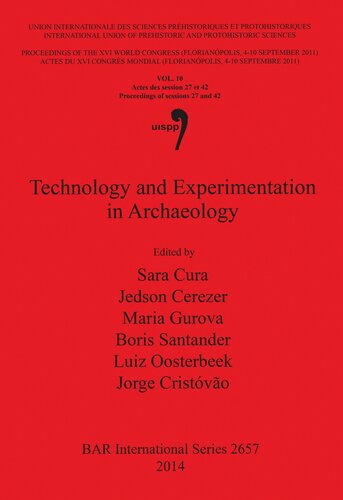

Most ebook files are in PDF format, so you can easily read them using various software such as Foxit Reader or directly on the Google Chrome browser.
Some ebook files are released by publishers in other formats such as .awz, .mobi, .epub, .fb2, etc. You may need to install specific software to read these formats on mobile/PC, such as Calibre.
Please read the tutorial at this link: https://ebookbell.com/faq
We offer FREE conversion to the popular formats you request; however, this may take some time. Therefore, right after payment, please email us, and we will try to provide the service as quickly as possible.
For some exceptional file formats or broken links (if any), please refrain from opening any disputes. Instead, email us first, and we will try to assist within a maximum of 6 hours.
EbookBell Team

5.0
68 reviewsExperimental Archaeology as an hypothesis contrast method, focusing on technological studies, is not new in archaeological research procedures. Since the early 1970s, as a consequence of the application of châine-operatoire/reduction sequence concepts within the framework of Palaeoethnological investigation, or within the actualistics studies highly developed in the framework of Processual Archaeology, the experimentation and utilization of artefact replicas have been used in the search for answers regarding technological procedures and their functional aspects. However, since the 1990s the research interface between technology and experimentation, worldwide, has increased, resulting in a renewal of procedures and interest in the incorporation of such studies particularly in the field of techno-functional analysis of prehistoric artefacts. Nevertheless the criticisms on experimental procedures are abundant, questioning its theoretical fundamentals and explanation validity. These remarks result both from the morphotypological approaches to artefact assemblages, but also from a lack of understanding on the range and goals of such studies. Stefano Grimaldi discusses the epistemological implications of experimental approaches. Experimentation on lithics are discussed in the papers of S. Cura, P. Cura, S. Grimaldi and E. Cristiani; G. N. de Souza and . P. Lima; B. de S. Barreto and M. P. Cabral; M. J. Rodet, A. Prous, J. Machado and L. F. Bass; G. N. Poplevko. Other papers discuss experimentation in the production of beads (M. Gurova, C. Bonsall, B. Bradley, E. Anastassova and P. Cura), new protocols on ceramics experimentation (J. F. Cerezer), ethnographic ceramic technology (R. T. Bortolin and V. Fróis), bone industry (B. Santander; C. Costa, N. Almeida, H. Gomes, S. Cura and P. Cura) and rock art engravings (N. S. da Rosa, S. Cura, S. Garcês and P. Cura).